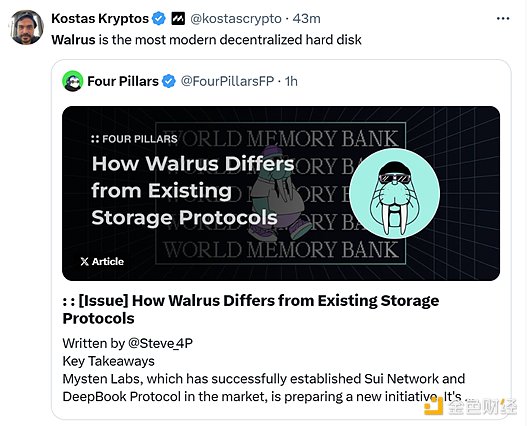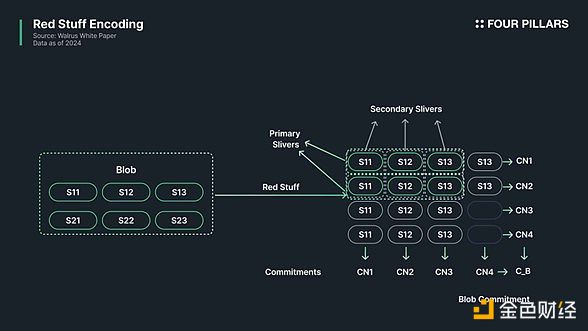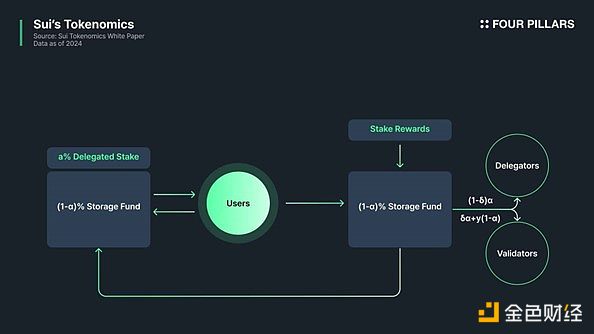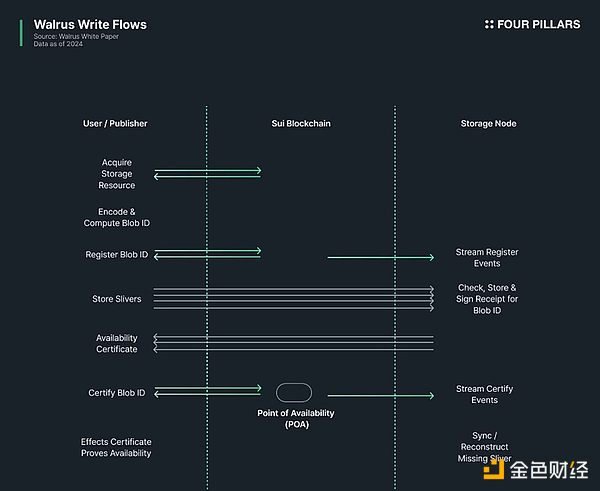Learn how Walrus is different from existing storage protocols

Reprinted from jinse
02/20/2025·3MSource: Four Pillars, translated by: Golden Finance xiaozou
"Walrus is the most modern decentralized hard drive," said Kostas Kryptos, co- founder of Mysten Labs.

Walrus is a decentralized storage protocol in the Sui ecosystem. In this article, we will explore in-depth how this protocol differs from other existing storage protocols.
Key points of this article:
-
Mysten Labs has successfully launched Sui Network and DeepBook Protocol in the market and is now preparing a new plan - Walrus Protocol .
-
Although there are many protocols in the decentralized storage market, Walrus is still attracting much attention, with two main reasons: 1) its cost-effectiveness and security far exceed existing storage solutions; 2) Through Sui Network , stored data can be achieved. Programmable.
-
Walrus is regarded as the most advanced project in existing decentralized storage protocols, and its future practicality and value will attract much attention.
1. Background introduction—Walrus? Why now?
Mysten Labs is now entering new fields through Walrus after successfully launching the Sui Network and Deepbook protocols. The success of Sui Network and Deepbook has brought great expectations to Walrus . However, despite the market's great interest in the Walrus protocol, there are still doubts about it.
These concerns stem from several points: the decentralized storage market has become saturated, many existing solutions have performed poorly, and the market is concerned about resource allocation issues - especially whether Mysten Labs continues to develop and expand Sui Network, as it continues to develop and expand Sui Network . New projects disperses resources.
Therefore, we will dig deep into the structure of the Walrus protocol, analyze its differences with existing decentralized storage solutions, and study Walrus ' relationship with Sui Network , focusing on how Walrus integrates with Sui 's architecture and enhances the Sui ecosystem.
1.1 Differences between Walrus and existing storage solutions
To understand the need for Walrus , we must first explore its differences from existing decentralized distributed storage solutions. From my point of view, Walrus has three significant differences from existing storage models (especially Filecoin and Arweave ):
1.1.1 Storage cost efficiency

First, there are significant differences in storage costs for Walrus , Arweave and Filecoin . As Four Pillars stated in the article on Walrus , Arweave requires all nodes to copy and store all data, while Filecoin allows users to decide the number of nodes to store data (the user can choose to store data by only one miner, or spread 100 copies of data in Of 100 different miners. Naturally, the more miners requesting to store data, the higher the cost).
In contrast, Walrus uses Reed-Stuff Encoding , which is significantly lower than Arweave and Filecoin , and is as efficient as 100 times (compared with Arweave , the latter requires data storage across the network, resulting in a replication cost of up to 500 times , while Walrus only needs 4-5 times copy to keep it efficient). At the same time, the probability of data loss is also significantly reduced.
In short, Walrus solves the shortcomings of Arweave and Filecoin . Arweave has low probability of data loss but high cost of copying, while Filecoin provides relatively economical storage based on user needs, but low-cost options can lead to higher risk of data loss. Walrus combines the advantages of both, maintaining low replication costs and minimizing the probability of data loss.
Furthermore, as the number of nodes increases, Arweave 's cost increases linearly, as all nodes/specified nodes must store a complete copy of the data. Walrus only needs to transmit network data once, and each node stores part of the data. As the network expands, the burden on a single node is reduced. This structural difference makes Walrus ' storage cost-efficiency significantly higher than Arweave and Filecoin .
1.1.2 Programmability
Although Walrus is better than Arweave and Filecoin in efficiency, the most significant difference from existing storage models is its "programmability". Traditional storage is only used as a simple data warehouse, while Walrus implements programmable decentralized storage through Sui Network , bringing its capabilities beyond basic data storage.
What if a smart contract can directly reference or trigger data stored in decentralized storage? For example, when casting an NFT, the image file can be stored in Walrus and its blob data object is created on the Sui Network , connecting it with the NFT object. This resolves the criticism of traditional NFTs being “incomplete” (i.e. tokens are on-chain, while NFT art metadata is stored off-chain), making NFT through Walrus a real Web3 asset.
Let me give you another example directly related to data storage. Since Walrus ' blob can be stored as Sui object and controlled through Sui 's Move smart contract, the smart contract can transfer the stored data to other users or automatically change ownership. That's why we say that the data in Walrus is programmable.
By contrast, the dynamic integration of Arweave and Filecoin with on- chain applications is limited or nearly impossible. Although Filecoin has added some smart contract capabilities through FVM (Filecoin virtual machine), data modification and control capabilities are still limited, which makes Walrus significantly better than both in terms of programmability.
1.1.3 Data access and deletion
One feature of existing storage protocols is that once the data is uploaded, it can be accessed by anyone and cannot be deleted. While this feature may be useful to individual users, there are significant limitations for institutions and businesses that need to store sensitive data or need to modify/delete data. By contrast, Walrus allows users to dispose or modify their data when needed (this is completely different from Arweave , where data cannot be deleted or modified; unlike Filecoin , where data deletion is not the user's wishes, but because of the contract. The node that stores user data is offline and no longer exists in the network).
Some people may be worried that this conflicts with the immutability principle of blockchain, but remember that only blob data is deleted in Walrus . Independently from blob data deletion, transaction data remains immutable, and deleting blob data will not affect the integrity of the blockchain.
Compared with traditional storage, Walrus 's enhanced practicality has increased its adoption potential in traditional enterprises and Web2 enterprises, and its versatility is highly anticipated in the future.
1.2 Synergy between Walrus and Sui Network
After exploring the differences between Walrus and existing storage protocols, we now look at the relationship between Walrus and Sui Network . When Mysten Labs announced the preparation of the Walrus protocol, many people were critical, questioning “Would they focus on Sui instead of creating another one?” However, as long as they have a basic understanding of how Walrus works, it will be understood that Walrus is not dispersed Sui 's attention should be regarded as a storage stack built to perfect the application on Sui . In other words, Walrus not only supplements Sui Network from a storage perspective, but also has a positive impact on Sui Network 's governance token SUI , making the two inseparable. Let's explore this in more detail.
1.2.1 The symbiotic relationship between Sui and Walrus
In fact, Mysten Labs had major concerns about the maintenance and management of storage during the initial design phase of Sui . This is because as the usage increases, the state of blockchain inevitably grows, which may eventually lead to an increase in transaction fees for Sui Network users in the future. Therefore, starting from Sui 's early design phase, Mysten Labs introduced a unique storage fund concept to address Sui 's storage challenges.

The Sui Storage Fund operates as follows: The fees submitted by users to Sui Verifiers are divided into 1) gas fees related to calculations and 2) storage costs of data storage. Sui charges users in advance the storage cost of permanent data storage and collects these funds into the storage fund. The storage fund continues to redistribute the accumulated amount to the validator when the data is still stored on the chain. Additionally, if users delete data, they can receive a refund for storage costs.
Sui 's unique on-chain data storage system produces two results:
-
Users can receive rebates for storage costs when deleting data on the chain, which creates economic incentives for reducing distributed ledger capacity.
-
The system addresses storage-related sustainability issues by charging storage fees in advance and using them as an incentive for future validators.
Although Sui solves sustainability issues through this unique structure, storing large blob data (such as media files) on chain is still a heavy burden. This is where Walrus comes in - through Walrus storing large blob data, while objectifying the metadata of blobs on Sui for control, the data can be programmable without directly storing it on Sui .

In addition, through Sui , Walrus implements the most significant features compared to other storage protocols, even if the stored data is programmable and controllable. Ultimately, Sui and Walrus form a symbiotic relationship, which create unique advantages and complement each other's limitations.
1.2.2 Walrus makes SUI tokens a deflationary asset
As the storage fund example shows, Sui Network requires that a certain number of Sui tokens be paid as the storage cost of storing any object. Walrus is no exception. When creating a blob data object in Walrus , Sui tokens proportional to the object size are locked in the storage fund.
Although some fees can be refunded when deleting data, some fees have a burning effect by permanently removing tokens in circulation. In other words, the more data stored through Walrus , the more Sui tokens permanently locked in the storage fund, forming a virtuous cycle, that is, the increase in Walrus usage leads to a decrease in Sui supply.
In short, the emergence of Walrus is good news for Sui Network, both from the perspective of network and assets, and the Sui ecosystem is expected to develop in a more diversified direction through Walrus.
2. Conclusion—Walrus will become Sui’s most critical agreement
2.1 Mysten Labs is not just building blockchains
When Mysten Labs first started, I thought it was just a company focused on Sui Network . However, after witnessing the launch of services like Deepbook and Sui Naming Service , I began to think about what the vision of Mysten Labs is. When I came into contact with Walrus , I came to the conclusion that their goal was to build a complete Web3 decentralized infrastructure.
Mysten Labs has a different time horizon from other companies when looking at this industry. They are not just issuing tokens, creating hype and selling; instead, they have a vision to lead innovation in all areas such as execution, storage, consensus and communications, while understanding and building for users who are accustomed to Web2 services The most suitable user interface.
Execution and consensus are handled by Sui Network (continued through programs such as Mysticeti and Pilotfish & Remora ), storage is run by Walrus , and communication is run by SCION , a next-generation Internet architecture that protects network packets, known for its DDoS and routing attacks— —Note that SCION is not created by Mysten Labs , but is mentioned for applying it to Sui Network ), while the user interface familiar to Web2 is managed by zkLogin , Stashed , SEAL and KELP .
If all of these plans succeed in taking root, I believe Mysten Labs can rewrite the existing Web3 paradigm. My initial thoughts were limited. Mysten Labs is not just trying to build a blockchain—they are a team that builds infrastructure for new networks. Of course, I believe Sui is at the heart of Mysten Labs’ vision, and other plans play a complementary role. The same goes for Walrus , which , in my opinion, is probably the most important protocol among them.
2.2 Walrus is not limited to Sui ecosystem
However, Walrus is not limited to the Sui ecosystem. Like other storage protocols, Walrus can be used by any third party outside of Sui applications, and it may even be a useful alternative to existing storage protocols or other DA layers (such as Celestia , EigenDA , Avail ).
This availability of Walrus extends the demand for Sui tokens beyond the scope of Sui Network . When Walrus is used, objects are created on the Sui Network , resulting in a decrease in Sui supply. In other words, Walrus has the potential to make Sui tokens a more attractive asset by creating external demand (this is not an investment proposal, but a structurally possible scenario). Therefore, Walrus is expected to become a bridge for Sui 's multi-directional expansion.
2.3 Can Walrus surpass Filecoin?
While comparing the value between specific protocols is a delicate question, I am very optimistic about Walrus ' future because: 1) its operational mechanism is much more efficient than existing storage protocols; 2) it can execute what existing storage protocols cannot do Tasks (become a DA or make stored data programmable); 3) It already has a solid network and user base through Sui Network .
If Walrus not only becomes the storage layer of Sui Network , but also becomes the representative storage protocol of Web3 as Mysten Labs envisioned, it may become a leading protocol in the storage field .


 panewslab
panewslab